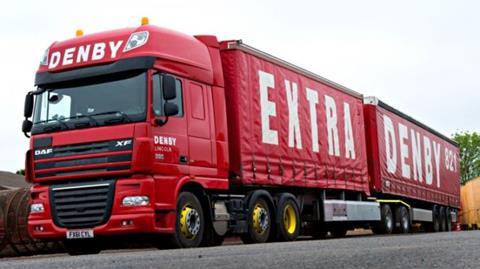
The government is considering a trial of 25-metre double artics on Britain’s roads as part of a wider multi-modal transport strategy.
The move follows the recent launch of a DfT consultation into the use of longer semi-trailers (LSTs) on the UK’s roads, following a successful seven-year trial which showed LSTs delivered significant cuts to mileage and CO2 emissions.
Denby Transport chairman Dick Denby recently met with DfT minister Baroness Vere to argue the merits of the 25.25m 60te B Double Road Train. Denby has been lobbying the government to trial the vehicle for over 20 years.
In a letter to Denby, following the meeting, Baroness Vere said: “I am willing to consider further proposals for the use of 25-metre combinations, but only if there is a good demonstration that there would be a significant demand for these vehicles.
“Indeed, I highlighted the importance of obtaining evidence about that when we met. When assessed for the Department previously in depth, albeit a long time ago, there were significant issues identified with their effectiveness, decarbonising, infrastructure and mode shift effects.
“I am aware that 25-metre vehicles are in use in, for example, the Netherlands and I am keen to understand whether there are lessons to be learnt.”
She added that as part of the DfT’s work on developing a multi-modal freight strategy for the UK “we may be able to consider whether further work on the viability of high capacity vehicles is warranted.
“Should there be significant support for this, and taking into account the potential impacts on rail freight, it may be possible to evaluate the viability of a trial.”
However Baroness Vere warned that there are a number of obstacles to the introduction of 25-metre long vehicles to the UK’s roads.
“Allowing them would be a significant policy change and would increase the maximum permitted length of a goods vehicle combination - not carrying an abnormal indivisible load - by about one third. This would be a major change for the motoring and general public,” she said.
Speaking to motortransport.co.uk, Dick Denby said he is currently working with the RHA to garner industry support for a trial of the 25.25-metre 60 tonne B Double Road Train, comprising of double-axle tractor with short double-axle semi-trailer equipped with a second fifth wheel connected to a second 13.6m double-axle semi-trailer.
Read more
- Operators could be allowed longer semi-trailers after successful trial
- DfT urged to make longer semi-trailers ‘business as usual’ for fleets
- Howard Tenens to lower CO2 emissions with Lawrence David longer semi-trailers
He called on MT readers to get behind his campaign to prove to Baroness Vere there is industry appetite for the vehicle.
Denby pointed to the Dutch experience where a trial of 25-metre vehicles garnered little industry interest at first with only 12 operators registered to participate.
“This was disappointing but was sufficient to enable the Hague to remove the limitations and substantially increase the numbers. Within three years 1,000 LHVs had replaced 1,500 standard vehicles. The early hesitance of operators evaporated when they saw them at work,” Denby said.
Denby also argues that the 25.25-metre 60-tonne B Double Road Train offers a much more efficient use of road space.
He said two of these vehicles could be used in place of three standard 16.5m semi-trailer combinations, with 52 pallets being carried per vehicle rather than the normal 35, which would deliver greater efficiency and productivity, cut the number of trucks on the roads, reduce overall fuel consumption and lower emissions, as well as requiring fewer drivers.
HazComp MD Kevin Buck - another advocate of the 25.25 metre 60-tonne B Double Road Train – said a UK trial of the vehicle is well overdue.
He said: "What is somewhat disappointing is that there are other transport innovations that would yield much greater results (than the longer semi-trailer) and which have been around for decades now, but which have yet to be considered for trial in the UK.
“The 25.25 metre 60 tonne B Double Road Train for example, championed by Dick Denby over 20 years ago, offers everything the LST does and so much more.
“It offers much greater productivity, efficiency and flexibility, whilst significantly reducing the CO2 emissions per tonne of freight moved compared to any other innovation being considered, or indeed, that of a current 44-tonne articulated vehicle.
“The 60-tonne B Double uses standard equipment, including standard length tractor units and 13.6-metre semi-trailers, whilst being compatible with all existing warehouse loading bay and general transport infrastructure. They can also conform to the standard 13.6-metre turning circle requirements of a conventional 44-tonne articulated vehicle."
Pointing to the successful adoption of these vehicles over the past 15 years in other European countries such as Scandinavia, Holland and more recently Spain, he said: “It is time the UK stopped playing catch up to our European cousins. With the challenges of leaving the EU compounded by the issues we face tackling climate change, transport efficiency, productivity and reduced emissions should not be a compromise or a choice between one or the other that we should have to make or accept."
He added: “It is vital that to retain our competitive edge whilst honouring our commitments to reducing vehicle emissions, the UK haulage industry is allowed to trial vehicles such as the 25.25-metre 60-tonne B Doubles immediately."














![DP World Modal Shift Programme Image[72690]](https://d2cohhpa0jt4tw.cloudfront.net/Pictures/100x67/4/9/7/17497_dpworldmodalshiftprogrammeimage72690_781836.jpg)